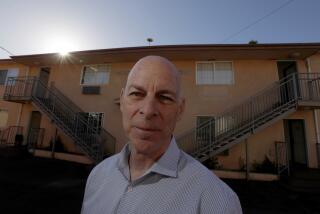HUD funds to help cities clean up foreclosures
Terry Ware, head of Denver’s housing and neighborhood development office, is a man under siege. The city is due to receive $6 million under an unusual federal program to help cities and counties deal with abandoned properties. Not surprisingly, there are many people in town who want help.
Representatives of several neighborhoods have pleaded for the funds to go toward cleaning up blighted houses that are dragging down property values. Homeowners struggling to keep their properties ask why they can’t have some of the money.
But with 2,000 Denver homes in foreclosure and thousands more expected to fall into that category, the money can go only so far. “It’s a drop in the ocean,” said Abdul Sesay, the analyst whom Ware has tapped to distribute the funds. “But it’s better than nothing.”
Across the country, cities and counties are performing housing triage as they prepare to spend the $4 billion Congress has allocated under the Neighborhood Stabilization Program.
Pushed by Rep. Maxine Waters (D-Los Angeles), the program is intended to help local governments buy, rehab and resell foreclosed homes -- or demolish them if that is the logical alternative.
“These homes that we’re talking about -- the grass grows long, the pools grow fetid, they become magnets for crime,” said Brian Sullivan, a spokesman for the U.S. Department of Housing and Urban Development. “It’s almost a viral effect.”
Sullivan acknowledged that the money available was nowhere near enough to solve the foreclosure problem across the country. “This gives them an opportunity to at least stanch the bleeding,” he said.
The funds come with a few strings attached: The money must be spent in low- to middle-income neighborhoods, and buildings can be resold only to buyers who earn 120% or less of an area’s median income. Governments, which had to submit plans to HUD by Dec. 1 to be considered for the program, have 18 months to spend the money.
“It’s like no other government program I’ve seen,” said Tom Palamar, city administrator in Pottsville, Pa., which is buying and demolishing a dozen homes on one notoriously blighted street. “They want to get the money on the streets, fast.”
Economists have questioned whether it makes sense to have the government flood the market with cheap homes, given that housing prices already are in a tailspin. They also note that many of the agencies have been unable to draw up detailed spending plans in the short time frame allowed, opening the door to possible abuse of the program.
California is the second-largest recipient of the housing aid, receiving $529 million. Los Angeles city officials expect to see nearly $33 million.
Mercedes Marquez, head of the city’s Housing Department, said her office had been planning for months how best to deploy the funds. Officials have spent thousands of dollars buying data and making detailed maps of foreclosures, she said, the better to zero in on 10-square-block areas across Los Angeles’ vast grids that have been hit the hardest.
The idea is to buy homes -- mostly in the northeast San Fernando Valley, South Los Angeles and Watts -- and rehab and resell them, as well as provide “soft second” mortgages to low-income families so they can buy homes.
“We can do that because L.A. still has a housing market,” Marquez said.
Still, the HUD money will not go far. According to the latest data, there have been 18,018 foreclosures in the city. Marquez estimates that Los Angeles will be able to buy 300 to 400 properties.
Florida is receiving the greatest amount of aid, at $541 million. But housing officials there say that total pales in comparison to the needs in the Sunshine State, where HUD statistics show that 8% of all home loans in the last 18 months are in foreclosure.
The cities and counties of the Tampa Bay area will receive about $100 million. Sharon West, manager of housing and community development for Tampa, summed up her city’s share of the money, $13.6 million, this way: “We’re going to get 110 houses out of it. That’s not a big impact when you have 1,800 houses in foreclosure.”
Tampa is targeting four neighborhoods hit hard by foreclosures, including the Sulphur Springs district, an old resort community littered with abandoned bungalows that were bought as investment properties during the real estate boom that ended last year. West said the city planned to demolish as many of those buildings as it could.
“If we just tear down and reduce the density and reinforce the areas that are being homesteaded, that will be a great accomplishment,” West said.
In Mesa, Ariz., where about 1 in every 20 houses is in foreclosure, officials are concentrating the bulk of their $9.6-million grant on one cluster of homes in the ZIP Code with the highest default rate.
Ray Villa, director of Mesa’s Neighborhood Services Department, said the Reed Park district was notorious for its abandoned ranch homes with shattered windows, doors off their hinges and trash blowing through dusty frontyards. But, he acknowledged, the government may have no more success reselling the few dozen homes it will be able to buy than their current owners have.
“It’s one of those things where you have to give it a shot and see if it works,” Villa said.
Ware, the Denver housing official, is skeptical too. His agency submitted plans to HUD that were as vague as possible because he is still unsure how best to spend the money. He said he’s hesitant to buy up homes because prices could continue to plunge, leaving taxpayers underwater.
“Our concern is that we still haven’t seen the bottom of the housing market,” Ware said. “Are we really stabilizing neighborhoods here?”
--
jessica.garrison@latimes.com
More to Read
Sign up for Essential California
The most important California stories and recommendations in your inbox every morning.
You may occasionally receive promotional content from the Los Angeles Times.










